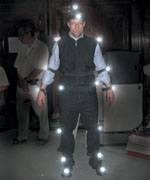Innovations Will Rock Commercial Sector
 |
| Alex Fuss, lead researcher for the Leading Edge Forum’s (LEF’s) Digital Disruptions report, has a graphic avatar named Fender Nighthawk. Today, an avatar must be created to participate in each virtual world, Fuss explains. In the future, users will be able to have a single avatar for traversing all virtual worlds, he predicts. |
Businesses, be aware and prepare. The latest wave of digital disruptions is rolling in, and future success depends on being ready for them and their effects. A comprehensive yearlong study reveals that, in the next three to five years, emerging technologies will reshape industry and initiate new business models.
Between now and then, however, the state of the commercial sector can best be described as chaotic, a condition that could last as long as a decade, experts say. Both traditional business models and their replacements remain on shaky ground, and the effects from the creation of a stunning capability, such as the perfection of quantum computing, quickly give rise to both opportunities and obstacles. To make the most of the opportunities and to avoid the obstacles, companies must be extremely agile and willing to take chances.
After months of investigation, a team of researchers led by Alex Fuss arrived at a list of seven digital disruptions that are likely to affect companies in the future. The chief technology officer for the financial services sector of Computer Sciences Corporation (CSC), headquartered in
Although CSC’s Leading Edge Forum (LEF) organized the research that went into the Digital Disruptions report, input was received from a number of experts from industry, government and academia. Among the contributors were personnel from Amazon.com, the Georgia Institute of Technology, NASA’s Jet Propulsion Laboratory and MetaRAM, a company that creates technology that increases the amount of server memory. Fuss’ studies also included reviewing research and opinions of experts in the field that encompasses the Internet, technology and society.
New media is the first of the seven digital disruptions that already are influencing business in the 21st century. It is all about interaction. Unlike the mega-mogul movie and television producers of the past century, today’s media content creators are sitting in front of their own computers in the comfort of their own homes; consumers are doing the same.
One of the first indications of the effect this change can have on businesses was the Writers Guild of America strike that centered on obtaining royalties for digital viewings of the writers’ material. Downloading digital material is not likely to replace DVD rentals or movie theaters any time soon, any more than the introduction of tape recorders replaced radio stations. However, a shift already is occurring and likely will continue, Fuss says.
The second digital disruption is what the researchers refer to as “living in a new reality”—virtual reality. Blending virtual and real worlds enables computer users to move between time and space, interact in new ways and enjoy new experiences, once again without leaving the comfort of their homes. Benefits to businesses range from controlling data centers remotely to companywide meetings without travel expenses. Companies will need to determine which technologies yield the most gains, then institute policies and procedures for taking advantage of them.
Network-centric is the buzz word in the military and has taken on new meaning with the introduction of social networks. This third digital disruption concerns the ability to locate and communicate with people who share similar interests or expertise, and it already is shifting the balance of power in advertising, money lending and music. Companies not only have to learn how to use this medium but also must accept that their employees are using social media in the workplace, so establishing reasonable guidelines is a must, Fuss says.
Information transparency is the fourth digital disruption and is a double-edged sword. It now is easier to find information about people and processes than ever before, enabling organizations to locate their employees and assets in real time. However, the expectation of information transparency from consumers will mean that government agencies as well as companies will have to find new ways to respond.
The fifth concern is that businesses need to pay attention to what the research team calls a new wave of waves. Discoveries about how better to use spectrum will cause its allocation to be an issue of the past. As a result, communications infrastructure will change in a way that opens the airwaves, which will become “fertile ground for a vast array of new services from new players,” the report states. While the team predicts consumers will be the big winners here, it is not clear at this point who the winners will be in the corporate sector.
Number six on the digital disruptions list is the introduction of next-generation computational power. While silicon has reigned supreme, its power over computing capabilities may be coming to an end with the emergence of new methods based on nanotechnology as well as molecular, quantum and optical computing.
Cryptography most likely will be the victim of this digital disruption. “You can imagine if you had a quantum computer that could factor large numbers quickly. Basically, all of our encryption schemes go out the window,” Fuss says. Quantum computers would have to be employed to generate the large numbers needed to encrypt adequately, and it becomes a cat-and-mouse game, he adds.
The final digital disruption the researchers predict involves the user-machine interface. While today’s computers have made work and play infinitely easier, problems remain. Interoperability, unexplained computer crashes and even the old-fashioned means of inputting data—using a keyboard—currently hinder the true usefulness of technologies. However, changes already are occurring in this area. Improvements in capabilities such as voice recognition and information sifting are quelling users’ frustrations. The growth of the use of topologies and semantics will enable organizations to solve problems faster, preventing crises.
 |
| Barcelona Media, a technology center that explores new media, straps reflectors to a person’s arms, legs, torso and head to capture motions via a camera. This information is then mapped onto an avatar. |
The team considered a number of other technologies for the list before settling on these final seven. Among them were collaborative technologies and cloud computing. The team chose not to single out collaborative tools because they are integral to a number of the items that made the list. And while he initially fought to include cloud computing, it did not seem as significant as it appears to be today, he says.
Digital disruptions not only will affect the way established companies do business but also will give birth to new types of industries, Fuss maintains. For example, in the financial services sector, a sector he is familiar with from his “day job,” peer-to-peer lending companies already are popping up. Rather than going the traditional route through a bank, credit union or savings and loan, people are going online and agreeing to lending terms among themselves.
Virgin Money,
Agreeing with Clay Shirky, consultant and adjunct professor in
As entrepreneurs continue to use innovative technologies to make money in new ways, established companies need to find different ways to create revenue. Fuss has some observations as well as advice in that area. In presentations to companies and organizations, he finishes with what he calls “Lessons for the
“You can’t stop the technology. As much as companies would like to keep out wireless and instant messaging, they haven’t been successful, nor will they be. You have to figure out how to channel it properly.
“The balance of power has swung to the customer. That’s a big theme across this report. Customers now are networked. They have information. For example, they can find out if there’s a hotel that doesn’t, say, maintain its building well and just not stay there. I see this across industries,” Fuss says.
Organizations should set themselves up to collaborate, he advises. “You no longer have to provide the whole solution yourself. You just have to facilitate the best minds that don’t necessarily have to be within your company,” he says. Wikis, virtual worlds and blogs are just a few of the communications tools available to organizations’ leaders to facilitate this collaboration, Fuss adds.
Borrowing from Nike and adding a twist, Fuss asserts that organizations should “just get started. There are some companies that are sitting on their hands and overanalyzing. You have to do some analysis, but it’s also good just to get started and put yourself in a position to benefit from other opinions, technologies … . There was a day when things were simpler. You could plan, spend a year or two defining your business and technology and roll it out slowly. Those days are gone.”
In this vein, he offers the example of one of CSC’s chief technology officers who a few years ago wanted to start a corporatewide wiki but wasn’t sure which technology platform to choose. Fuss advised him to choose the one that he felt would do the best job, then make the first question on the wiki, “Which wiki technology should we use?”
Another of Fuss’ enterprise lessons addresses the diffusion of control that information-sharing technologies are bringing about. Consumers not only have a lot of information, they also decide if they will pass it along. To take advantage of this, enterprises should leverage new media, video, viral media as well as word of mouth to get their corporate message out.
“Don’t fret about loss of control; just make more money,” he says. “A key message, particularly in this report, is that it’s not about technology. It’s disrupting business. The technology is what’s causing the disruption, but what needs to be focused on is the disruption to business and how to capitalize on this new stuff,” Fuss adds.
Although it is the technology that is causing the disruption, Fuss points out that technology is not the only way to handle the changes it brings with it. He advises members of organizations to network by attending conferences and making the human connection. “It’s really people that are going to make all this happen. We’re at the stage where computers aren’t smart enough to just do everything for us as far as information and idea generation. But we’re at the stage where they can assist us,” he says.
The model for the near future is using technology to sift through data and find information that interests people and then people connect to make use of it, he adds. One example is Twine, a company that uses semantic technology to scour the Internet and deliver information to the desktop based on the user’s interest.
Although the digital disruptions enumerated in the report appear to center around tools, Fuss believes the real focal point will be information. He agrees with an opinion expressed by Yochai Benkler, Berkman Professor of entrepreneurial legal studies,
Until about 1850 and the Industrial Revolution, no major changes were seen in nations’ economies. The next big changes were experienced in the 1950s with the computer revolution and the 1980s with the Internet revolution. “But Benkler says we’re actually entering a completely new era from a gross domestic product perspective, bigger than all of those. In the Internet revolution, we just added a layer of information on top of a hard-goods-based economy. We have information about cars, houses and all of that, and it helps us, but the economy is still based on cars and houses. Benkler says that in the networked-information economy, which is what we’re entering, the information is the primary value and the hard goods are of minimal value,” Fuss explains.
“Forewarned is forearmed; businesses must be aware of these disruptive technologies if they are to successfully navigate the unprecedented changes we anticipate over the next several years and beyond,” he adds.
Web Resources
Digital Disruptions report: http://assets1.csc.com/features/downloads/12409_2.pdf
Digital Disruptions Blog: www.csc.com/ee/lef/C20
CSC’s Leading Edge Forum: www.csc.com/aboutus/leadingedgeforum/
Virgin Money: www.virginmoney.com/worldwide
Twine: www.twine.com




Comments